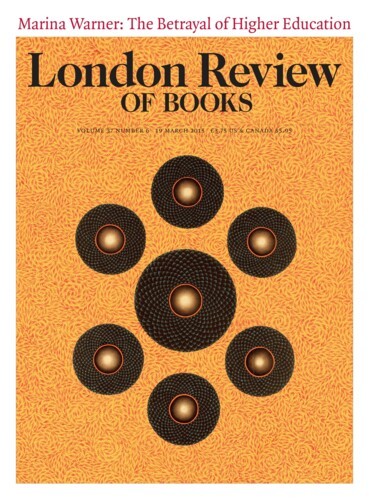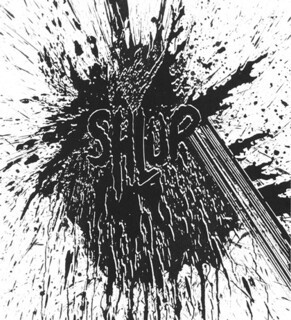Christian Marclay ’s new show (at White Cube Bermondsey until 12 April) is all about teaching you to hear with your eyes. Surround Sounds, its centrepiece, is a soundproofed room full of people watching sound in silence. The graphic sound effects from thousands of comic books have been cut out, animated and projected onto the walls. Blue rectangles with the word ‘tap’ on them jump up and down at floor level. A multicoloured ‘crack’ fractures to reveal more ‘cracks’ below, then fractures again. ‘Ssh’ streams across the walls, saturating them: silent noise instructing the viewer to be silent. Flocks of ‘vip’ fly from one side to the other before giving way to large blocks of ‘chang’ and ‘thunga’, then vertical streams of ‘choom’. It’s a cacophony, but the only sound you hear comes from the occasional visitor who can’t help putting what he’s seeing into words – it’s a nagging temptation – before catching himself, embarrassed, and shutting up.1
The noises you hear in your head as you watch Surround Sounds might sound something like the kind of art Marclay was producing in the early 1980s, soon after his graduation from the Massachusetts College of Art, when he was best known as a mangler of LPs. They might sound like a particularly battered copy of Record without a Cover (1985), a run of single-sided LPs with the message do not store in a protective package engraved on them. The records would get noisier as the grooves deteriorated over time and the original audio was covered over by a carapace of ‘cracks’, ‘sshs’ and ‘vips’.2 Marclay played the turntable as an instrument – as hiphop artists had been doing since the late 1970s – at gigs on the New York avant-garde scene, using distressed records like Record without a Cover to improvise Bruitist musical collages.3 At one point he claimed in an interview that he could ‘scratch’ better than any hiphop turntablist, and he tried to persuade hiphop artists to perform with him.
Marclay’s background as a DJ had some bearing on The Clock, the work he’s now best known for. The Clock meticulously edited thousands of movie clips of clocks – or of people looking at clocks, or talking about the time – into a film that can be shown over 24 hours with the times onscreen corresponding to the actual time. Zadie Smith called The Clock ‘neither bad nor good but sublime’, and it is, both for the staggering amount of work that went into gathering and trimming the footage, and for the way it subsumes the whole history of cinema into the telling of the über-story, the passing of time. But it’s also a massive remix. Marclay took fragments of other people’s work, as DJs do, and recombined them into something new, altering their meaning. ‘My reason for pulling out of DJing,’ Marclay said in an interview with David Toop at around the time The Clock went crazy, ‘is that I feel that records have lost their meaning in a strange way. They’re not the objects that we all used to interact with and that brought us all the music we enjoyed.’ The Clock was a way of DJing without records; and Surround Sounds is a way of playing distressed records without records, a way of remixing noise using images.
The paintings on show at White Cube remix noise with paint. The sound effects have been screen-printed onto canvases that have been pre-painted with abstract marks, using brushes, sponges, mops and a water pistol. ‘Pop’ doesn’t appear graphically, but it’s always in the background: the screen-printed onomatopoeia, some of it in Ben-Day dots, blows raspberries at works like Roy Lichtenstein’s Whaam! But the backgrounds invoke Pollock and the abstract expressionists. As Tom Morton puts it in the exhibition catalogue, ‘Bringing together the techniques of gestural painting and mechanical printing, one a product of an impossible-to-replicate moment, the other of a process designed always to give the same results, he fuses a knowing riff on Pollock with a knowing riff on Andy Warhol.’ In other words, Marclay is DJing with the history of art, and hiphop is part of that story too: the larger paintings also resemble vivid graffiti pieces, old-school hiphop’s visual mode of expression.
There’s a room of small paintings each containing a single sound: a red and yellow splattered ‘plop’ on bogey green; a ‘splish’ in pink and purple mesh on orange; a ‘gloop’ that looks like a squashed heart, blood red on azure with the ‘gloop’ running diagonally across it. There’s a room full of bigger paintings that contain several sonic events. One of them has a whizzing ball of orange at its centre that spins your eye out either to a ‘blub blub blub blub’ over blue bubbles or to a ‘sploosh’ over an exuberant burst of green – a forlorn sinking feeling or a climactic explosion, depending on how it catches you. Colours and fonts seem to take on sonic properties. The pink in a pink ‘plop’ on grey reappears in the ‘splish’, and you hear its frequencies reiterated. Nobbly fonts sound different from bald ones, which sound different from spidery ones. Some of the paintings, such as a white creamy ‘slup’ with sea-green highlights, or a custard yellow ‘bloop’ on a background of blueberry muffin, elicit tastes too. Some of the paintings don’t quite work, in that the background colour or font doesn’t seem to match the sound effect. But that only heightens the weirdness of the rest of it, because it reminds you that what you’re looking at are pictures, not sounds at all.
Pub Crawl – 11 looped videos projected simultaneously along the White Cube’s main corridor below waist height – has a very different register. Where Surround Sounds and the paintings are joyful, borderline garish, Pub Crawl is downbeat, its colours subdued. You follow Marclay’s shoes and the bottom of his trousers as he walks through East London at daybreak tapping and rolling the bottles and glasses left behind by revellers the night before. The videos are of different lengths so the ‘music’ formed by the tinkling is polymorphous and unpredictable. It wouldn’t sound out of place on Records (1997), a compilation of Marclay’s early sound works, and there are obvious connections to Record without a Cover: objects being used in ways they weren’t intended to be, wrecked music made from wreckage. But Pub Crawl also has a Lefebvrian subtext about the limits of our freedom to engage with the objects and spaces around us. Marclay is alone, but the bottles and glasses suggest vanished crowds, and as you walk past the projectors your legs are silhouetted against the walls, making crowds of shadows. Most of us are slaves to the clock, Marclay seems to be saying, shuttled from work, to inebrium, then obediently to bed; and we end up excluded from ways of experiencing the city that are full of creative potential. We don’t play bottles at dawn, and we don’t do graffiti. The message that our free time is controlled and compartmentalised is enforced in the show’s final room, in which empty wine and beer glasses have been arranged on a shelf at waist height – bar height – along the sides of the space. But of course you can’t play percussion on them, and a man in a dark suit is standing in the corner making sure you don’t. ‘Ssh’ streams across the walls in Surround Sounds; the unrestrained visitor swallows his ‘thunga’, and slinks out.
Send Letters To:
The Editor
London Review of Books,
28 Little Russell Street
London, WC1A 2HN
letters@lrb.co.uk
Please include name, address, and a telephone number.


